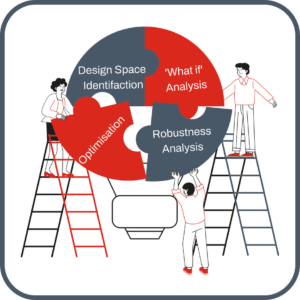Digital with a Purpose
Would you buy a car to travel to a tropical island?
Most likely, you would reconsider your options. Intuitively, you understood that to succeed with the objective of traveling to the island, a means of transport which is more water resistant might be a smarter choice. So, when it comes to digitalization, we should take the same approach, i.e. start with the objective and then determine how best to achieve this goal.
As the industry embraces the principles of Pharma 4.0 and runs full steam ahead into digitalization plans for their operations, it’s more important than ever to to plan to purpose.
The concept of “modeling for a purpose” can directly be extended to digital twins and perhaps digitalization as a whole. The commonly offered advice, “Do not simply digitalize an existing workflow but re-think the workflow with new digital capabilities in mind”, is yet another point in case. Digitalization is an opportunity to transform the ways of working in the industry but many gains can be left on the table if the projects are not managed carefully and with purpose.
What is the objective?
What do you want to achieve and what would your measures of success be? Say for instance, you would want to maximize product concentration, then by how much and in comparison to what? By explicitly and specifically formulating the objective(s) it becomes tangible and it allows you to define what you need in order reach it.
Set your goals and step back

Is the objective just a piece of a bigger puzzle, is it just one step in the journey? By zooming out and thinking of the bigger picture, a common theme is easier to identify which can be addressed holistically rather then taking a siloed approach for each individual piece. Siloed problem-solving results in siloed tools and technology.
This enlarged view may seem daunting from an implementation perspective but is an essential planning activity. Consolidating this digitalisation map does not mean that a complete solution needs to be implemented to cover it all at the start but rather helps to set the frame for an interconnected puzzle.
For instance, knowing the conditions that produce maximum product concentration is not the end task but rather one piece in the process development puzzle. In fact, at this stage a step-wise, approach can be the preferred route.
How often?
It is vital to consider how often a task will be performed before choosing a solution. An ad hoc, manual approach may be the best plan for truly one-off tasks or goals, while not being suitable for more repetitive tasks.
Consider that while tasks may have differing goals they still may be similar in nature and procedure. For instance, for one product, the minimum economically viable concentration could be 2g/L, and for the next, 1.5g/L. Despite their differing goals there is procedural knowledge that can be carried over from one product to the next. While it may be tempting to maintain the status quo, new approaches, tools, services, or solutions from external providers may be more efficient in the long term – despite the initial investment in time and effort.
Who?
Though not evident, who is involved and who should be involved can be an objective of its own. The guiding principles should be that:
- Everyone who makes an effort should get a return from the project
- Everyone should do the task they are most suited for
We have seen that by involving the key stakeholders at an early stage creates crucial early momentum and the essential buy-in to get the project puzzle over the line – piece by piece.